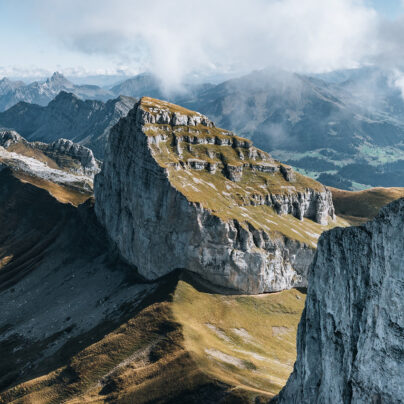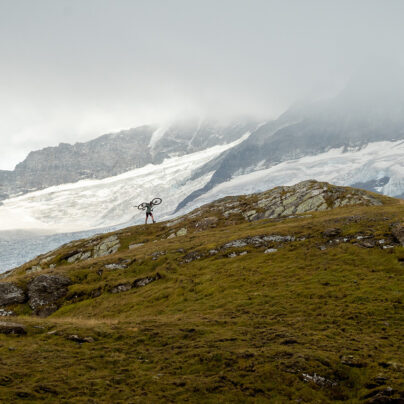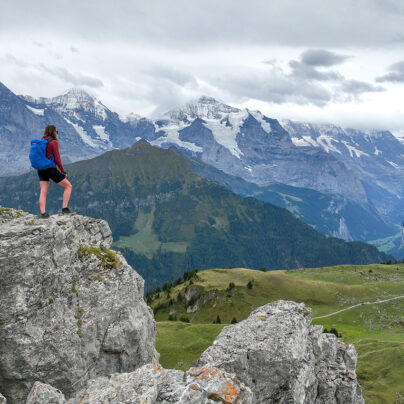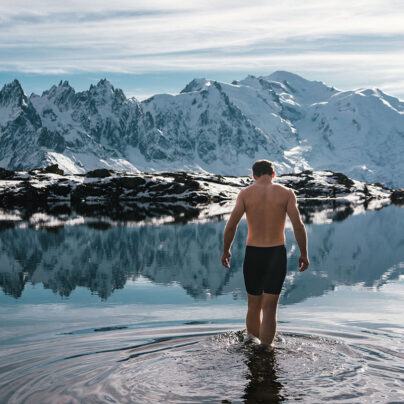Out West
A Bikerafting Traverse of the Outer Hebrides
Written by Aaron Rolph // Photography by British Adventure Collective & Jim Cossey
‘Now through the narrowing between sharp rocks, I’m exposed to the full wrath of the Atlantic swell, meeting the wind-blown waves I’m almost surfing on. The ocean’s waves grapple against each other. Agonisingly rough seas throw me at all angles and force me to make constant corrections to keep my boat on track.’
An enormous orca leaps clean into the air and plunges back down, splashing into the ocean. It’s a welcome that Jim and I won’t forget as we step out onto the viewing deck for some fresh air while our ferry steams through the Minch. Utilising the royal flush of transport to get here (car, train, bus, and ferry), this journey may have taken an entire 24 hours, but we have certainly reached one of the extremities of the United Kingdom. The whale gives us another flyby before presumably returning to its pod, and we finally dock in Stornoway, capital of Lewis and Harris. These are the same seas we are hoping to cross on a packraft with our bikes attached. I’m fairly sure orcas could make quick work of our blow-up boats if they wanted to, but I park that hopefully far-fetched scenario – there are plenty more pressing matters to worry about.
Our goal is to combine a rugged mountain-bike route through the archipelago of the Outer Hebrides, carrying inflatable packrafts and making the sea crossings between these remote islands self-propelled. With the usual prevailing wind coming from the south and south-west, we planned our route to head north. In the days leading up to the trip, however, the wind patterns were looking mixed. In fact, the forecasts generally predicted a strong northerly – which would heavily impede our progress – so we made the unconventional call to start at the top of the islands.
We push off away from the Butt of Lewis Lighthouse, over 300km from our end goal of Barra, to find ourselves already battling a punchy headwind. Our clever plan is already backfiring. Despite this, with fresh legs and good intentions, we get our heads down. Without too much to look at in this landscape that seems rather bleak and featureless to us, we make quick work of the first 50km before reaching our first camp spot. This stunning beach has wild Atlantic waves crashing down onto its white sands; this is exactly what we came for. We pitch our tents on the edge of the dunes looking onto an eternity of soft, golden light skimming over the waves – light that, nearing summer solstice this far north, really does go on for hours.



Ever the wild coffee connoisseur, Jim pulls out a tasty grind he’s prepared especially for the trip, even boasting its own personalised branding. After the final sips of Brazil’s finest brew, and the inevitable packfaffing, we bid farewell to one of the finest camp spots, and with it any hope of good weather.
Wishing to experience the interior of these islands, we decide to take the beeline route through the rugged hills of Lewis and Harris. The rough gravel we’re following eventually peters out to nothing at all as we go deeper into the mountains and further from what visible signs of civilisation we come across. The dark skies loom over us, mirroring the mood as the reality of the gruelling hike-a-bike becomes ever more apparent. But, although progress is laboriously slow as we carry our fully laden bikes over never-ending peaks and troughs, we take solace having seen this coming from researching our route. A wall of big mountains and dramatic hanging valleys appears to be getting slowly but surely closer and, with it, taller – a landscape that wouldn’t look out of place in Norway.
The further into these wild mountains we go, the more it feels as though nature is doing all it can to stop us passing. The shelves of peat we’re forced to climb over are getting taller, now over head-height in places, and the bogs seem to be getting deeper with water. Every corner we turn, the strong wind and rain picks up until the downpours are torrential, and so perfectly horizontal it’s amazing that they even touch the ground. Seven hours of hiking later, we’re deeply relieved to join singletrack once again and excited to be back on our bikes. After hours of thinking about this very moment, we can’t believe it; the wind is now whipping through the valley at such a rate that our progress is yet again brought to an intermittent standstill. Gritting our teeth a little longer, we’re eventually spat out of the Lewis hills back onto a road, and after a blast over some beautiful singletrack tarmac, we reach the pub just in time for last orders.


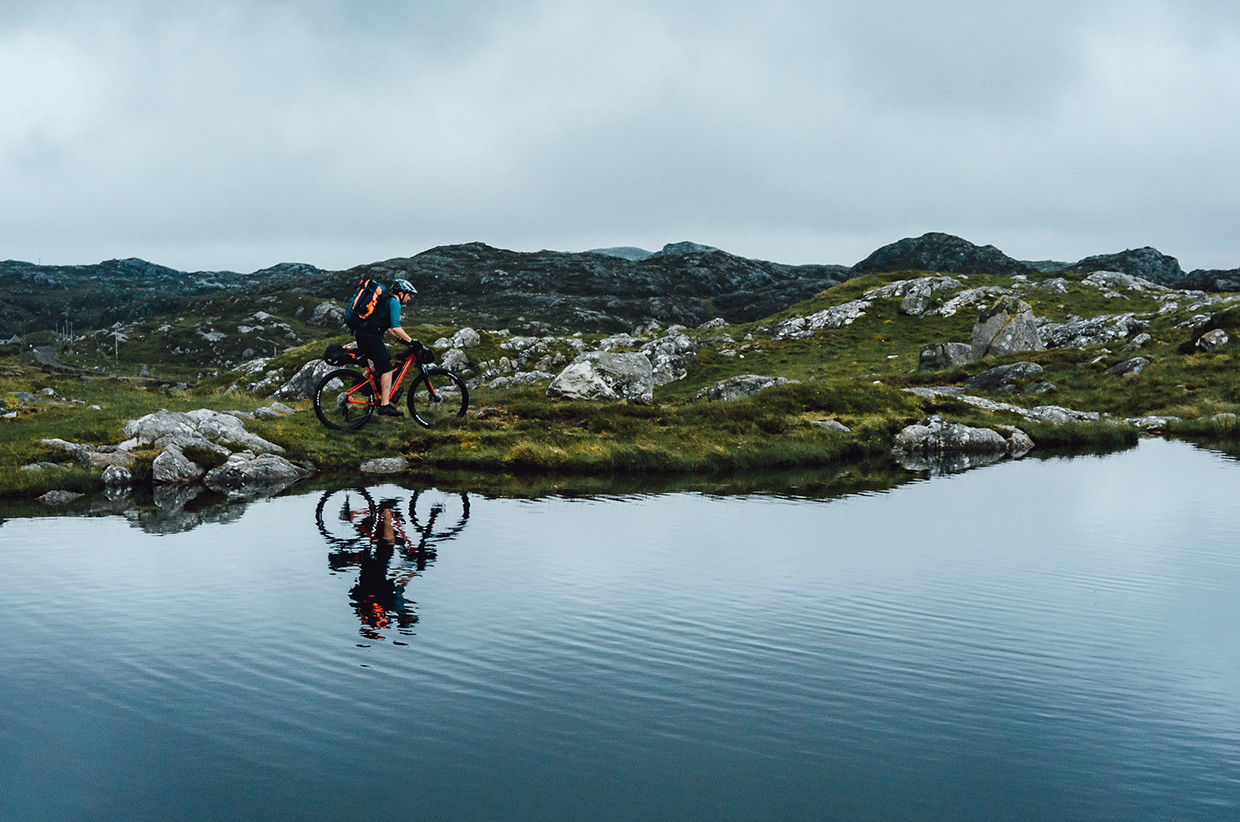
The following morning, we get stuck into the rugged and beautiful coastline of Harris, where the ups and downs don’t show any signs of abating. We’re treated to some fine singletrack skirting bay after bay as we hug the water’s edge. Eventually, we reach the end of the UK’s largest island (aside from the mainland and Ireland, that is). However, the real uncertainties still lie ahead of us.
After hours of thinking about this very moment, we can’t believe it; the wind is now whipping through the valley at such a rate that our progress is yet again brought to an intermittent standstill.
I’d hoped we’d be able to paddle the sea crossings using a packraft, which to our knowledge would be the first time such a journey had been completed. However, undertaking this isn’t without its dangers. Would these inflatable boats really prove to be seaworthy? After a long call with the coastguard discussing conditions and our proposed route, we’re warned solemnly of the force-six winds coming from the south and the very poor sea visibility. As determined as I am to follow through on this pipedream, this is a serious crossing – and, despite their many strengths, packrafts are notorious for being affected by wind. It’s clear that, despite the best intentions, paddling today would be at best irresponsible. At worst, life threatening.
Disenchanted, but confident the right decision has been made, we board the passenger ferry to the next island of Berneray before undertaking a shorter, more sheltered paddle from there to the misty island of North Uist. The islands are flatter, but boast yet more amazing beaches. The clear tidal waters support an impressive range of wildlife including otters, owls, and sea eagles.



The next day starts like every other: fighting rough-and-ready peaty singletrack against an ever-present strong headwind. Today, however, proves to be different. Much to our excitement, the wind direction finally decides to play ball, doing a complete U-turn. The original plan is finally falling into place. By mid-afternoon we’re riding a beautiful tailwind all the way to South Uist. Now facing the Sound of Barra, we’re just about able to make out the islands in the distance, which are a full 10km or so away. Although the wind is still tearing through these islands, this time it is in our favour and I’m determined to cross this sea under my own steam. Extremely determined.
With limited experience paddling packrafts, Jim has made the reasonable decision to bow out, leaving me to go this one alone. I can’t help but wonder if I’m a madman to go this alone, but it does mean that if things don’t go to plan then Jim will be on dry land to coordinate a response. With all sorts of thoughts spinning around my head, my fears are certainly heightened – but, after some rough calculations on wind, it’s time to face the music. I set sail with my bike neatly affixed to my boat, initially encouraged by the flat water and the wind blowing from the land behind. The swell soon starts to build, however. And as I point my raft towards the open sea, it dawns on me how exposed I really am. The waves continue to crash overboard, but I feel a growing confidence as I near a rock passage I must carefully navigate. I bid farewell to the Isle of Eriskay on my left – which, only a few kilometres away, was my plan B if things didn’t work out.
Now through the narrowing between sharp rocks, I’m exposed to the full wrath of the Atlantic swell, meeting the wind-blown waves I’m almost surfing on. The ocean’s waves grapple against each other. Agonisingly rough seas throw me at all angles and force me to make constant corrections to keep my boat on track. After what feels like a lifetime as a sitting duck, I eventually reach some protection from the previously unrelenting Atlantic by hugging the east coast of the uninhabited island of Fuday. The swell from the wind barely lets up until I eventually crash down on the beautiful beaches of Barra, a full two hours after setting off from Uist. The relief to be back on dry land is overwhelming and I call Jim to let him know I’m alive and well before transitioning back to bike mode.
Once Jim has joined me, we set about pedalling round the small island of Barra. Still buzzing from the paddle, to me this feels more like a victory lap as our 300km journey comes to an end. With a packraft, you will always be second in command to nature and the conditions it brings. However, I’d proven to myself, and maybe to others, that it’s possible to cross even the wildest of seas by bike and packraft, entering a whole new horizon for self-propelled travel.
Words by Aaron Rolph // @aaronrolph
Photography by Aaron Rolph (@aaronrolph) and Jim Cossey (@jim_cossey) on behalf of @britishadventurecollective
Supported by Salsa Cycles // @salsacycles




